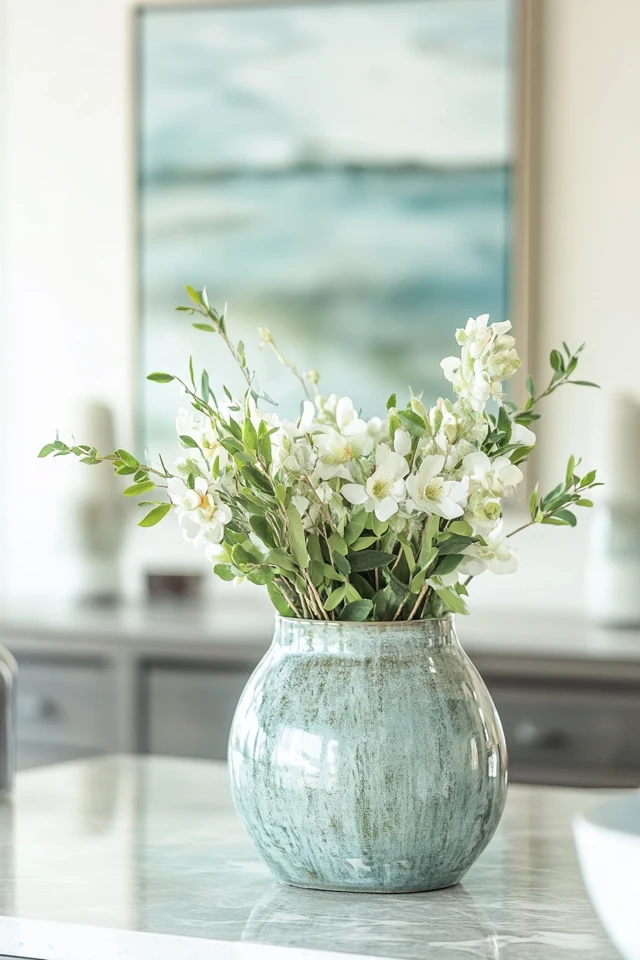Introduction
There’s something inherently calming about natural elements. They ground us, reconnecting our homes with the beauty of the earth. When combined with coastal-inspired design, these natural elements take on a breezy, serene quality, transforming your space into a tranquil retreat that feels both refreshing and rooted. Incorporating coastal natural elements into your decor is more than just a style choice – it’s a way to bring balance, warmth, and authenticity into your home.
I fell in love with coastal design during a trip to a remote beach. What stood out to me wasn’t just the ocean’s vibrant hues but the natural textures and materials that surrounded me – the smooth driftwood scattered along the shore, the golden warmth of the sand, and the soft grasses swaying in the breeze. When I returned home, I knew I wanted to channel those natural elements into my living space. By weaving in materials like jute, rattan, and unfinished wood, I created a grounded, coastal-inspired look that brought that same sense of peace indoors.
If you’re looking to infuse your home with natural textures, oceanic colors, and organic accents, this guide will show you how to incorporate coastal natural elements in a way that feels authentic, elegant, and grounded.
The Perfect Design for You
A coastal natural look is perfect for anyone who loves the tranquility of the ocean and the warmth of natural materials. It’s ideal for creating spaces that feel calm, welcoming, and connected to the natural world.
Imagine a living room with a driftwood coffee table, a woven jute rug, and soft linen curtains fluttering in the breeze. Or picture a bedroom with light wood furniture, layers of soft, natural fabrics, and the subtle addition of seashells and coral accents. A grounded coastal look brings nature into your home in a way that feels timeless and effortlessly stylish.
Picture Gallery
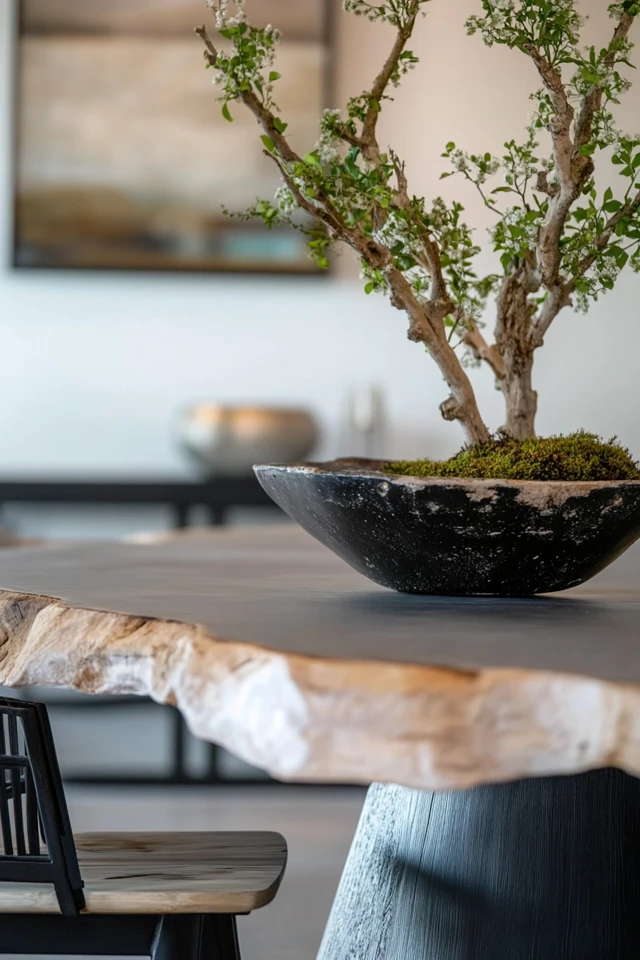
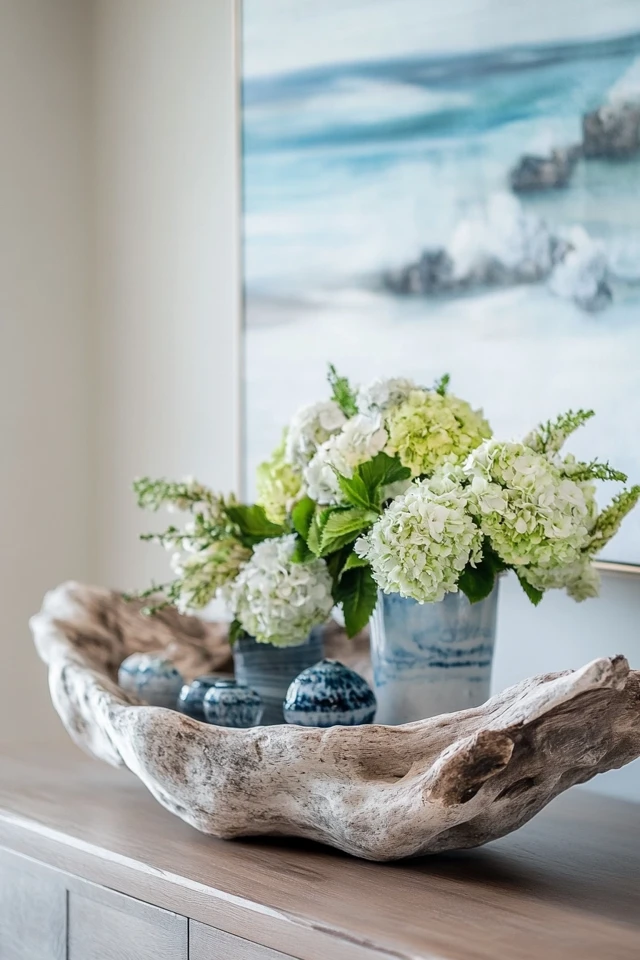
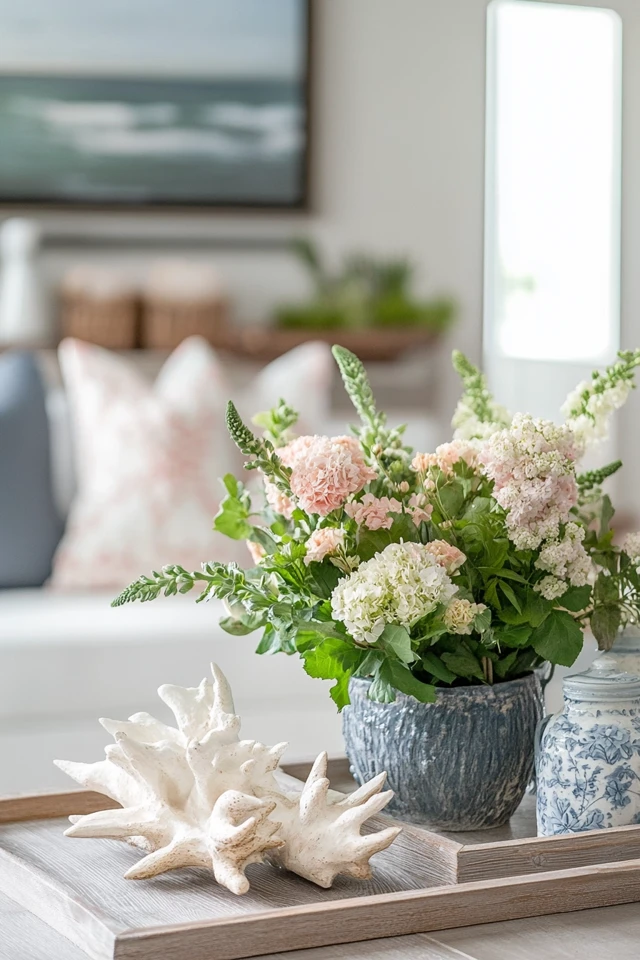
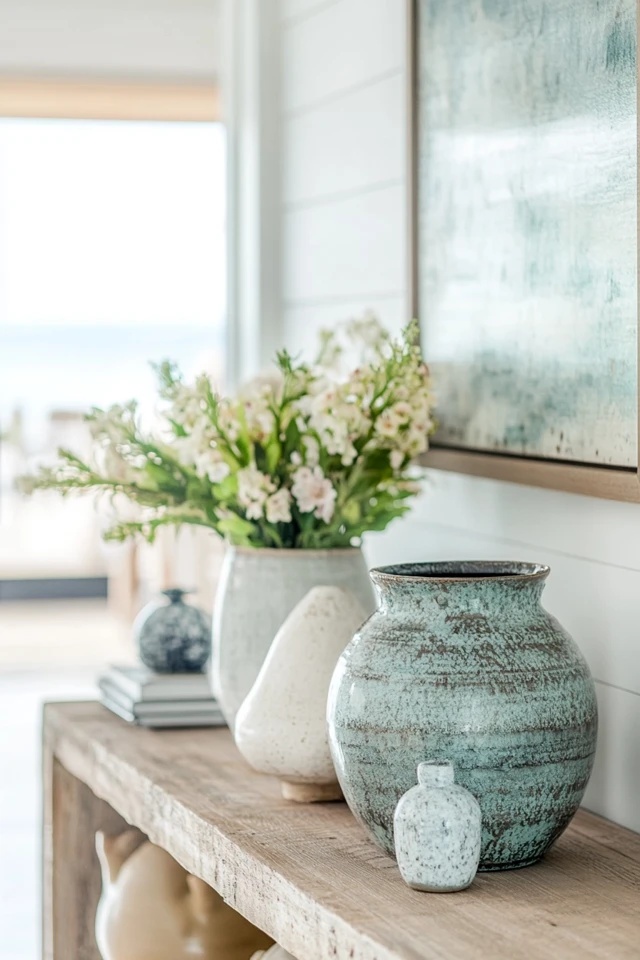
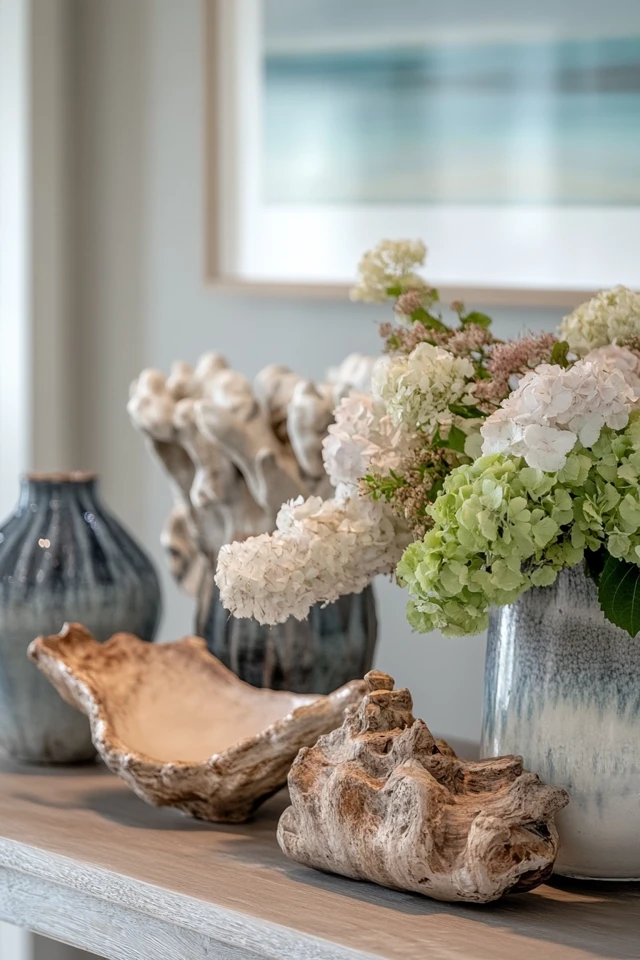

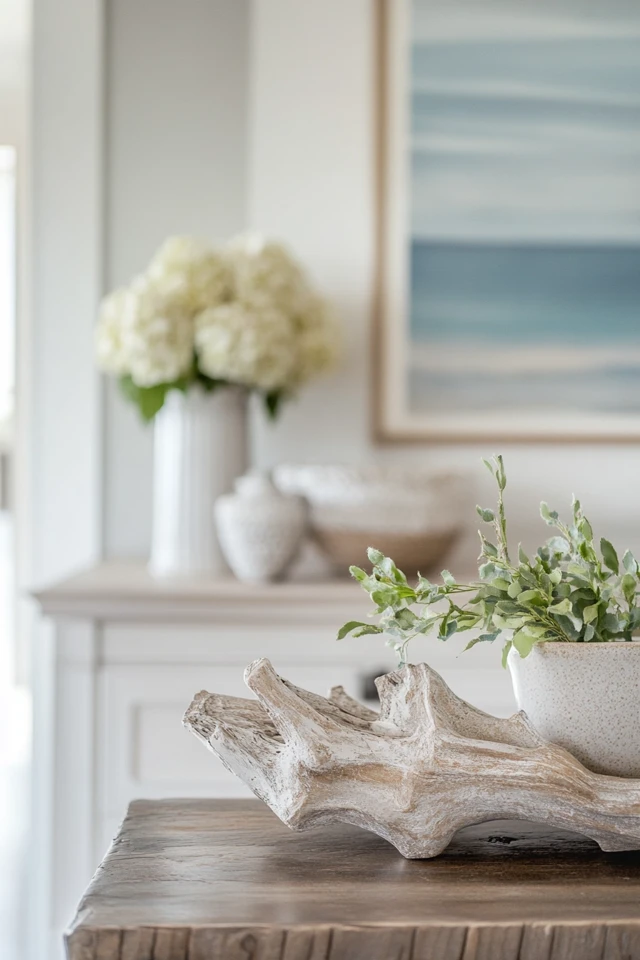
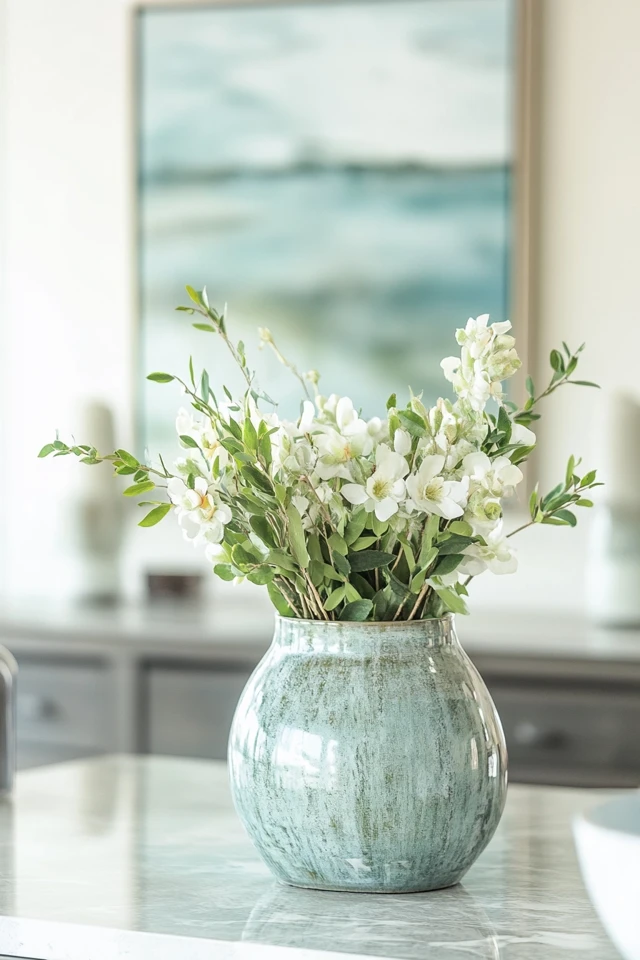
Why Coastal Natural Elements Work So Well Together
Coastal natural elements work beautifully together because they evoke a sense of harmony and balance. Here’s why these elements are so effective in creating a grounded look:
- Organic Materials: Natural elements like wood, jute, and rattan add warmth and texture, grounding the space while maintaining a light, breezy feel. Evidence-based design shows that these materials foster a connection to nature and improve well-being.
- Soothing Color Palette: Coastal-inspired colors – like sandy beiges, soft blues, and seafoam greens – create a calming, cohesive backdrop that enhances the natural materials.
- Layered Textures: Combining different natural textures, such as woven baskets, linen upholstery, and seagrass rugs, creates depth and visual interest while keeping the space feeling relaxed and cohesive.
- Subtle Coastal Accents: Organic decor, like driftwood sculptures or coral-inspired pieces, adds personality without overwhelming the space, maintaining the grounded aesthetic.
- Timeless Appeal: Natural materials and coastal elements never go out of style, ensuring that your space feels fresh and relevant for years to come.
Together, these elements create a look that’s both grounded and uplifting – a perfect balance for any home.
How to Incorporate Coastal Natural Elements: Step-by-Step
- Start with a Neutral Base
Use neutral colors on your walls and larger furniture pieces to create a clean, calming backdrop. Shades of white, beige, and light gray provide the perfect foundation for layering natural elements.- Paint Tip: Use “Seashell” by Benjamin Moore or “Shoreline” by Sherwin-Williams for a coastal-inspired neutral.
- Choose Natural Flooring or Rugs
Highlight natural materials underfoot with hardwood flooring, woven jute rugs, or seagrass mats. These elements add warmth and texture to the space. - Incorporate Wooden Furniture
Opt for light or weathered wood finishes for a coastal look. A driftwood-inspired coffee table, a reclaimed wood dining table, or light oak chairs can anchor the space while adding character. - Add Woven and Textured Accents
Bring in rattan, wicker, or bamboo furniture and decor. Consider a rattan armchair, woven pendant lights, or wicker baskets for stylish storage. - Layer Soft Natural Fabrics
Use linen, cotton, and other natural textiles for curtains, upholstery, and throw pillows. Stick to light, airy colors or soft stripes for a coastal touch. - Incorporate Driftwood and Shell Accents
Display small pieces of driftwood, bowls of seashells, or coral-inspired sculptures on shelves, mantels, or side tables. These organic accents tie the space to the ocean while keeping the look grounded. - Add Greenery for Freshness
Bring life to your space with plants like potted palms, snake plants, or trailing ivy. Use natural planters made of terracotta, woven seagrass, or stone to enhance the organic vibe. - Include Light and Airy Window Treatments
Opt for sheer curtains or light linen panels to let in natural light while maintaining the breezy, coastal feel. - Incorporate Functional Natural Decor
Choose items that are both beautiful and practical, like woven trays, driftwood candle holders, or stone coasters. These details add authenticity while keeping the space functional. - Tie the Look Together with Art
Hang artwork inspired by the coast, such as abstract wave paintings, framed beach photography, or minimalist line art depicting oceanic elements.
FAQ Section
1. Can I achieve a grounded coastal look on a budget?
Yes! Thrift stores and flea markets are excellent places to find affordable natural materials like wicker baskets, wooden furniture, and driftwood decor. DIY projects, like painting secondhand furniture or creating your own shell arrangements, can also help you save money.
2. How do I keep my space from feeling too “beach-themed”?
Focus on subtle natural elements and avoid overly literal motifs like anchors or ship wheels. Let the textures, materials, and colors evoke the coast without being too on-the-nose.
3. Can I mix coastal natural elements with other styles?
Absolutely. Coastal natural elements pair well with modern, rustic, and even bohemian styles. For example, mix rattan furniture with sleek metal accents for a modern twist or layer in colorful textiles for a boho-inspired look.
4. What’s the best way to incorporate natural elements into a small space?
Use natural materials in key accents, like a woven basket for storage or a driftwood-framed mirror, and keep the color palette light to make the room feel airy and open.
5. How do I maintain natural materials like wood and rattan?
Dust regularly and use gentle cleaners. Avoid excessive moisture, which can damage materials like rattan and seagrass, and keep wooden pieces polished to maintain their finish.
Variations
- Minimalist Coastal Natural: Focus on clean lines and a monochromatic palette with a few natural accents, like a jute rug and a light wood coffee table.
- Rustic Coastal Natural: Incorporate weathered wood furniture, galvanized metal accents, and muted tones for a farmhouse-inspired coastal look.
- Boho Coastal Natural: Add colorful woven textiles, macramé wall hangings, and layered patterns for a relaxed, eclectic vibe.
- Luxury Coastal Natural: Use high-end materials like marble, velvet, and brass alongside natural elements for a more upscale take on the style.
- Outdoor Coastal Natural: Style a patio or balcony with rattan furniture, outdoor-safe jute rugs, and potted greenery for a fresh, grounded look.
Conclusion
Incorporating coastal natural elements into your home is about more than just decor – it’s about creating a space that feels grounded, serene, and connected to the beauty of the natural world. By combining organic materials, soothing colors, and thoughtful accents, you can transform any room into a timeless retreat that feels as refreshing as a day by the ocean.
Whether you’re redecorating your living room, bedroom, or outdoor space, these tips will help you create a look that’s authentic, elegant, and uniquely yours. Start small, experiment with textures, and let nature guide your design. I’d love to see how you’ve incorporated coastal natural elements into your space – share your photos and ideas, and let’s inspire each other to create homes that bring us closer to the beauty of the coast!

